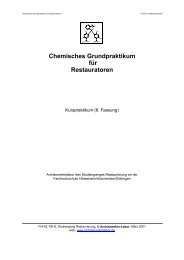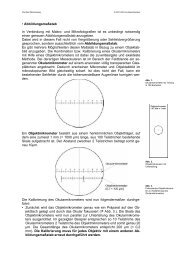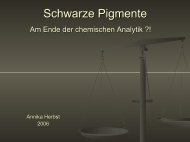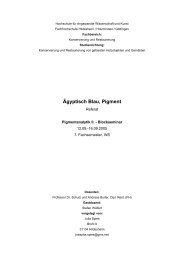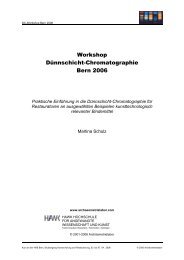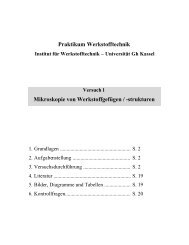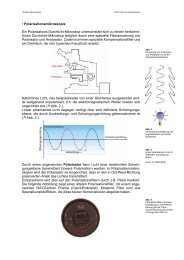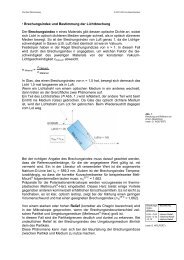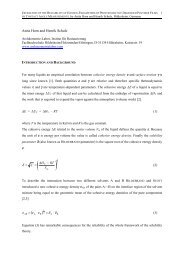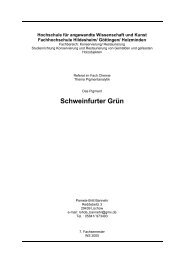Henrik Schulz* and Anita Horn, Archäomertrie-Labor der HAWK ...
Henrik Schulz* and Anita Horn, Archäomertrie-Labor der HAWK ...
Henrik Schulz* and Anita Horn, Archäomertrie-Labor der HAWK ...
Create successful ePaper yourself
Turn your PDF publications into a flip-book with our unique Google optimized e-Paper software.
Manuscript, H. Schulz <strong>and</strong> A. <strong>Horn</strong>, Hildesheim, henrik.schulz@archaeometrielabor.com 12<br />
Contact Angle Measurements<br />
Contact angle measurement occurs by the Sessile Drop Method with a video-based optical<br />
contact angle meter, equipped with an electronic syringe unit (OCA 15plus, DataPhysics<br />
Instruments GmbH, Germany). The measurement is carried out at room conditions. SCA 20<br />
software, Version 1.6, is used to operate the instrument <strong>and</strong> to calculate contact angles as well<br />
as free surface energy of the solid samples.<br />
Settings : Syringe type: Hamilton 1750 TLL (500 µl) used with a replaceable dosing needle<br />
with a inner diameter of 0.1 mm (Art.-No. 5132-1/4-B, GLT mbH, Germany).<br />
Drop type: normal, drop volume: 5 µl, dosing rate: 4 µl/s<br />
Frame grabbing time 20 s (25 images/s).<br />
Calculation method for the sessile drop: circle fitting (neglects gravity).<br />
Test Liquids: Water, water/ethylene glycol mixtures <strong>and</strong> aqueous solutions of CaCl2 (see table<br />
2).<br />
Colorimetric Measurements by UV/VIS-Spectroscopy<br />
Dye: Toliudineblue O, Chloride salt, dye content ~ 80%, Sigma-Aldrich Chemie, Steinheim<br />
Dye processing: Sodium hydroxide was added to a 10 -4 molar aqueous solution, to convert the<br />
dye salt into the dye base. The solution was covered with n-Hexane <strong>and</strong> shaken out for 15<br />
min. using a ultrasonic bath. Later on the mixture was transferred to a separation funnel <strong>and</strong><br />
the upper n-hexane phase with the imino form of the dye was separated.<br />
Procedure of dyeing: the samples were dyed by immersion using a Chromatogram Immersion<br />
device (CAMAG), two samples at a time. Time of dyeing: 10 min.<br />
Method of Measuring : UV/VIS-Spectroscopy, Tidas diode array spectrometer, J&M GmbH,<br />
Aalen, Germany; diffuse reflection, 45° optics, ∅ of measuring spot approx. 1,5 mm<br />
Settings: Absorbance, scan parameters: 300-800 nm, Step 1 nm, time of integration: 50 ms,<br />
time between two scans (time interval): 10 s, accumulation of scans: 10.<br />
Settings for spot <strong>and</strong> scanning measurements: The means out of 170 spot measurements of the<br />
treated samples <strong>and</strong> 30 spots of the reference for each species of wood.



